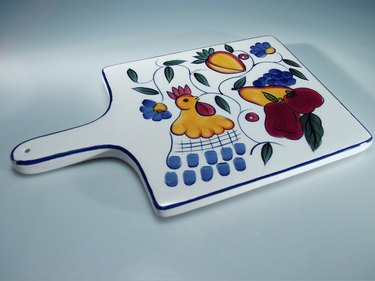
Wooden tabletops, especially those finished with varnish or lacquer, are easily marred by setting hot pots and pans on the surface. To protect table surfaces from scorching and discoloration, place a trivet underneath the pan to absorb the container's heat. The most protective trivets are suspended above the table surface or made from heatproof materials.
Trivet Styles
Video of the Day
Some trivets have tiny legs that suspend hot pans far enough above the table surface to protect it from heat. Others are made from materials that provide a protective barrier between pans and tabletops. Expandable trivets are adjustable to accommodate small to large pans. Other trivet styles include versions with interlocking pieces that can be configured for pans of different shapes; some consist of strands of heatproof beads that can be manipulated into circles, squares or figure-eights.
Video of the Day
Natural Material Trivets
Wood and cork trivets are inexpensive, decorative and effective heat barriers. Wooden varieties come in rustic, unfinished styles as well as stained, carved and painted versions. Cork trivets are good table protectors and should be at least 1/2-inch-thick for adequate tabletop protection. Homemade cork trivets can be cut into different shapes from cork wall tiles and painted with acrylic artist paint.
Metal Trivets
Sleek looking stainless steel trivets add a modern touch to table settings and provide maximum protection for tables. Wrought iron trivets give the tabletop décor a European flair and are often sold in sets that include several artistic designs. Both types of metal trivets can be safely cleaned in automatic dishwashers.
Ceramic and Porcelain
Among the prettiest trivets, these styles are decorated with art reproductions, unique modern designs and brightly colored geometric patterns. Glazed or unglazed, they hold up under the heat of the hottest pots and pans. Hand wash ceramic and porcelain trivets to protect the designs on their surfaces.
Tile Trivets
Pick up some remnant floor or countertop tiles at a hardware store or home improvement center and cut them into trivets of varying sizes and shapes. Mixing and matching ceramic and natural stone tiles adds color and depth to your tabletop dressing.
Trivet Features
To ensure stability, trivets with legs should have non-skid bottoms. Choose flat trivets with felt protectors on the bottom to protect tabletops from nicks and scratches. Avoid trivets made from paper or cardboard as they may adhere to the table's surface if they become wet or soiled with spilled food.